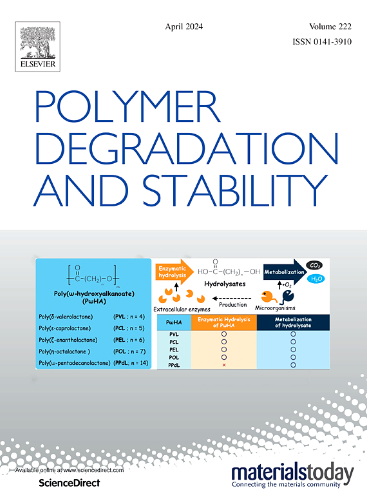Enhancing the fire barrier performance of cotton fabrics via polyamidoamine-based coatings
IF 6.3
2区 化学
Q1 POLYMER SCIENCE
引用次数: 0
Abstract
This study investigates the potential of enhancing the fire barrier performance of cotton fabrics by combining α-amino acid-based polyamidoamines (PAAs) with different charge distribution, recognized for their char-forming ability, with smectites of varying aspect ratios. To this purpose, various PAAs coating formulations were applied to cotton fabrics and assembled with polyurethane foam within a mockup assembly to be evaluated under forced combustion conditions (75 kW m⁻²) in the Cube test. Preliminary tests on six PAAs and four smectites identified the cationic, arginine-derived PAA (M-ARG), known for its strong interaction with sodium montmorillonite, as the most promising candidate when combined with laponite. While PAAs alone did not significantly improve barrier performance, the M-ARG/laponite combination (total 16 % by mass add-on) delayed foam liquefaction and the release of liquid pyrolyzates from polyurethane foams by about 21 s. The correlation between the results obtained from Cube test and full-scale chair mockup test, confirmed that treated fabrics can delay the fire growth and the heat release peak rate by over two minutes. These findings demonstrate the effectiveness of char-forming nanocomposite coatings in enhancing fire barrier performance and validate the Cube test as a reliable, cost-efficient, and practical method for material development, reducing the reliance on extensive full-scale testing.
聚酰胺基涂料提高棉织物防火性能的研究
本研究探讨了不同电荷分布的α-氨基酸基聚酰胺胺(PAAs)与不同宽高比的蒙脱石相结合,提高棉织物防火性能的潜力。为此,我们将不同的PAAs涂层配方应用于棉织物上,并将其与聚氨酯泡沫组合在一个模型中,以在强制燃烧条件下(75 kW m⁻²)进行立方体测试。对6种PAA和4种蒙脱石的初步测试发现,阳离子精氨酸衍生的PAA (M-ARG)与蒙脱石钠具有很强的相互作用,是与拉脱石结合时最有希望的候选者。虽然单独使用PAAs并不能显著提高屏障性能,但M-ARG/laponite组合(总质量添加量为16%)将泡沫液化和聚氨酯泡沫中液体热解产物的释放延迟了约21秒。立方体测试结果与全尺寸椅子模型测试结果的相关性证实,经过处理的织物可以将火焰生长和热释放峰值速率延迟两分钟以上。这些发现证明了炭成型纳米复合涂层在提高防火性能方面的有效性,并验证了Cube测试是一种可靠、经济、实用的材料开发方法,减少了对大规模全面测试的依赖。
本文章由计算机程序翻译,如有差异,请以英文原文为准。
求助全文
约1分钟内获得全文
求助全文
来源期刊

Polymer Degradation and Stability
化学-高分子科学
CiteScore
10.10
自引率
10.20%
发文量
325
审稿时长
23 days
期刊介绍:
Polymer Degradation and Stability deals with the degradation reactions and their control which are a major preoccupation of practitioners of the many and diverse aspects of modern polymer technology.
Deteriorative reactions occur during processing, when polymers are subjected to heat, oxygen and mechanical stress, and during the useful life of the materials when oxygen and sunlight are the most important degradative agencies. In more specialised applications, degradation may be induced by high energy radiation, ozone, atmospheric pollutants, mechanical stress, biological action, hydrolysis and many other influences. The mechanisms of these reactions and stabilisation processes must be understood if the technology and application of polymers are to continue to advance. The reporting of investigations of this kind is therefore a major function of this journal.
However there are also new developments in polymer technology in which degradation processes find positive applications. For example, photodegradable plastics are now available, the recycling of polymeric products will become increasingly important, degradation and combustion studies are involved in the definition of the fire hazards which are associated with polymeric materials and the microelectronics industry is vitally dependent upon polymer degradation in the manufacture of its circuitry. Polymer properties may also be improved by processes like curing and grafting, the chemistry of which can be closely related to that which causes physical deterioration in other circumstances.
 求助内容:
求助内容: 应助结果提醒方式:
应助结果提醒方式:


